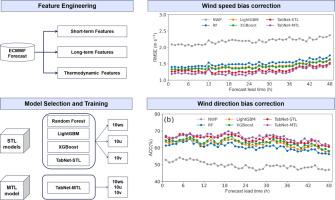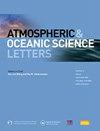基于多任务机器学习模型的海上近地面风场预报灵巧偏差校正
IF 3.2
4区 地球科学
Q3 METEOROLOGY & ATMOSPHERIC SCIENCES
引用次数: 0
摘要
对于数值天气预报模式来说,海上风场的短期准确预报仍然是一个挑战。基于欧洲中期天气预报中心综合预报系统全球模式(ECMWF-IFS)在山东省沿海14个海上气象站3年的48小时预报数据,引入了TabNet-MTL模型,该模型显著改善了近地面风向和风速的预报偏差。TabNet-MTL采用特征工程方法,以均方误差作为损失函数,并采用5重交叉验证方法保证训练模型的泛化能力。与单任务版本(TabNet-STL)和其他三种流行的单任务学习模型(Random Forest, LightGBM和XGBoost)相比,它在所有站点不同预测提前期的风场校正方面表现出了卓越的技能。结果表明,该方法将ECMWF-IFS风速预报均方根误差从2.20 m s - 1显著降低到1.25 m s - 1,将风向预报精度从50%提高到65%。作为一种可解释的深度学习模型,气象站和近地面风速的长期时间统计数据是TabNet-MTL特征工程中影响最大的变量。摘要目前, 数值业务预报模式对沿海站点短期风场的准确预报仍存在挑战. 本研究基于欧洲中期天气预报中心ECMWF-IFS的高分辨率模式未来48小时的预报数据,构建适用于沿海风场订正的热动力特征,关键变量的短期和长期统计特征,引入多任务深度学习模型(TabNet-MTL)对山东省14个沿海气象站的风向和风速预报同时进行订正。相比于多个单任务学习模型(随机森林,LightGBM, XGBoost和TabNet-STL), TabNet-MTL模型具有显著的偏差订正优势,风速预报的均方根误差从2.20 s−1降低到1.25年代−1,风向预报准确率从50%提高到65%。此外,TabNet-MTL模型具有可解释性,特征重要性表明气象站点和近地面风速统计特征对风场订正的改善具有较大贡献。本文章由计算机程序翻译,如有差异,请以英文原文为准。

Skillful bias correction of offshore near-surface wind field forecasting based on a multi-task machine learning model
Accurate short-term forecast of offshore wind fields is still challenging for numerical weather prediction models. Based on three years of 48-hour forecast data from the European Centre for Medium-Range Weather Forecasts Integrated Forecasting System global model (ECMWF-IFS) over 14 offshore weather stations along the coast of Shandong Province, this study introduces a multi-task learning (MTL) model (TabNet-MTL), which significantly improves the forecast bias of near-surface wind direction and speed simultaneously. TabNet-MTL adopts the feature engineering method, utilizes mean square error as the loss function, and employs the 5-fold cross validation method to ensure the generalization ability of the trained model. It demonstrates superior skills in wind field correction across different forecast lead times over all stations compared to its single-task version (TabNet-STL) and three other popular single-task learning models (Random Forest, LightGBM, and XGBoost). Results show that it significantly reduces root mean square error of the ECMWF-IFS wind speed forecast from 2.20 to 1.25 m s−1, and increases the forecast accuracy of wind direction from 50 % to 65 %. As an explainable deep learning model, the weather stations and long-term temporal statistics of near-surface wind speed are identified as the most influential variables for TabNet-MTL in constructing its feature engineering.
摘要
目前, 数值业务预报模式对沿海站点短期风场的准确预报仍存在挑战. 本研究基于欧洲中期天气预报中心ECMWF-IFS的高分辨率模式未来48小时的预报数据, 构建适用于沿海风场订正的热动力特征, 关键变量的短期和长期统计特征, 引入多任务深度学习模型 (TabNet-MTL) 对山东省14个沿海气象站的风向和风速预报同时进行订正. 相比于多个单任务学习模型 (随机森林, LightGBM, XGBoost和TabNet-STL) , TabNet-MTL模型具有显著的偏差订正优势, 风速预报的均方根误差从2.20 m s−1降低到 1.25 m s−1, 风向预报准确率从50 %提高到65 %.此外, TabNet-MTL模型具有可解释性, 特征重要性表明气象站点和近地面风速统计特征对风场订正的改善具有较大贡献.
求助全文
通过发布文献求助,成功后即可免费获取论文全文。
去求助
来源期刊

Atmospheric and Oceanic Science Letters
METEOROLOGY & ATMOSPHERIC SCIENCES-
CiteScore
4.20
自引率
8.70%
发文量
925
审稿时长
12 weeks
 求助内容:
求助内容: 应助结果提醒方式:
应助结果提醒方式:


